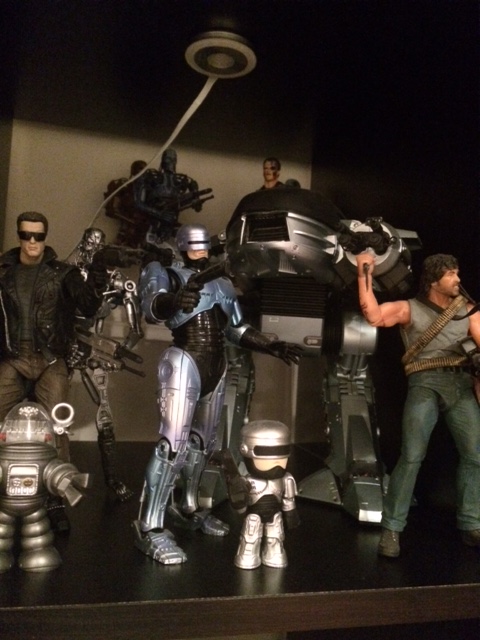Somewhere in a block of the Expedit nearby is this scene: If you remember Ed-209 (and all the other action figures I would rather have than Ed-209– see E290,) here Ed-209 appears to be joined by a bunch of...
Somewhere in a block of the Expedit nearby is this scene:

If you remember Ed-209 (and all the other action figures I would rather have than Ed-209– see E290,) here Ed-209 appears to be joined by a bunch of other metallic guys, like Robocop, the Terminator with and without skin, and Rambo. Also, maybe that robot from Futurama? It doesn’t look like him, but maybe.
What I like about this setup is that like the previous “ready to go” figures there is a sense of coherence, dramatic action, and maybe a theme, but this also follows a kind of grey and silver color scheme. These silver figures feel much more serious in their monochromatic corporate greys, even as their movies critique some aspects of corporate culture.
This brings me back to a perennial question, perhaps THE only question, about why my husband collects action figures. Though many of my blog posts have been concerned with memory, nostalgia, and childhood, I also know there is the careful concern of the adult world that enters into collecting, as much as there is a childlike joy and delight in unboxing a figure and getting it “ready to go.” In other words, adult people collect action figures for many different reasons. For many it is simply an investment, for others they are curators or archivists of different lines, franchises, or collections.
My husband certainly appreciates those forms of collecting, but I wouldn’t say he is driven by any of those impulses primarily. Unboxing figures decreases their value, and my husband has never been a completist, looking for every figure in a line. However, in looking at Ed-209 looming behind the shoulder of Robocop, there is also something not childlike, not nostalgic, but plagued by the care for the art of action figures. The care of “getting something just right.” It isn’t just about the sculpt or the points of articulation or the pose, (getting the figures away from “vanilla poses” like the heroic stance with arms to the side and down.) Instead, there is a kind of celebration for detail, complexity, and a meticulous performance of care itself. When I think of Justin’s collection, it isn’t a set of figures boxed and catalogued or preserved, but a set of figures arranged, in thoughtful, expressive, communicative detail. Even if no one is looking, listening, or paying attention.









